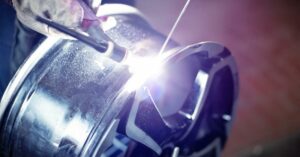Want to boost your telescope’s performance without breaking the bank? Painting the inside of the tube is a simple yet effective DIY project that can make a noticeable difference. Stray light bouncing around inside the tube can reduce contrast and make faint objects harder to see. A properly painted interior absorbs this stray light, improving image quality.
The goal is to create a surface that absorbs as much light as possible. Flat black paint is the go-to choice because it scatters light in many directions, preventing it from reaching your eye. Avoid glossy or semi-gloss paints, as they reflect light more directly.
Also Read
So, let’s dive into how to paint the inside of a telescope tube!
What You’ll Need:
- Flat black spray paint: Look for a paint specifically designed for metal or with good adhesion properties. Some brands market “ultra-flat” or “matte” black paints, which are ideal.
- Cleaning supplies: Soap, water, and a clean cloth or paper towels. Isopropyl alcohol is also helpful for removing grease and grime.
- Masking tape or paper: To protect areas you don’t want to paint (like the ends of the tube or any mounting hardware).
- Sandpaper or steel wool (optional): Use this to rough up the surface if the tube is very smooth or glossy.
- Drop cloth or newspaper: To protect your work area from overspray.
- Safety gear: Eye protection and a respirator or mask to avoid inhaling paint fumes.
The Process:
- Disassembly: Carefully remove any optical components (mirrors, lenses, etc.) from the telescope tube. This is crucial to avoid damaging them with paint. Take photos or note how everything is assembled so you can put it back together correctly.
- Cleaning: Thoroughly clean the inside of the tube with soap and water to remove any dust, dirt, or grease. Rinse well and let it dry completely. For stubborn grease or residue, use isopropyl alcohol. A clean surface is essential for good paint adhesion.
- Surface Preparation (Optional): If the inside of the tube is very smooth or glossy, lightly sanding or using steel wool can help the paint adhere better. This is especially important for metal tubes.
- Masking: Use masking tape or paper to carefully cover any areas you don’t want to paint. This includes the tube’s ends, mounting rings or hardware, and internal baffles (if present). Take your time with this step to ensure clean lines.
- Painting: Now comes the fun part! Shake the spray paint well according to the manufacturer’s instructions. Hold the can about 8-10 inches away from the inside of the tube and apply thin, even coats. Avoid spraying too much paint in one spot, which can cause drips and runs.
- Multiple Coats: Applying several thin coats over one thick coat is better. Allow each coat to dry completely (usually 15-30 minutes, depending on the paint and temperature) before applying the next. This will prevent runs and ensure a smooth, even finish. Aim for complete coverage and a uniform, flat black appearance.
- Drying Time: Once you’ve applied the final coat, allow the tube to dry completely for at least 24 hours, or as the paint manufacturer recommends. This is important to ensure the paint is fully cured and won’t off-gas or cause any issues when you reassemble the telescope.
- Reassembly: After completely dry paint, carefully remove the masking tape and reassemble the telescope. Double-check your photos or notes to ensure everything is returned in the correct order and orientation.
- Test the paint: Before painting the entire tube, test the paint on a scrap piece of metal or cardboard to ensure you’re happy with the color and finish.
- Work in a well-ventilated area: Spray paint fumes can be harmful, so work outdoors or in a well-ventilated space.
- Be patient: Don’t rush the drying process. Allowing each coat to dry completely is crucial for a good finish.
Can you paint an inner tube?
Yes, you can paint an inner tube, but it’s generally not recommended and rarely necessary. Inner tubes are made of flexible rubber, which tends to flex and expand. Most paints, especially rigid ones, will crack and peel when the rubber stretches. If you must paint an inner tube, you need a specialized flexible paint designed for rubber or vinyl. Even then, the paint might not hold up well to repeated flexing.
Does the inside of a telescope need to be black?
Ideally, yes. Black is the best color for absorbing stray light. The purpose of painting the inside of a telescope tube is to minimize reflections and scattering of light within the tube. This stray light reduces contrast and makes it harder to see faint objects. While dark gray might offer some improvement over a light-coloured interior, black is the most effective color for this purpose.
How to clean the inside of a telescope?
Cleaning the inside of a telescope tube depends on whether you’re cleaning the tube itself or the optical components (mirrors or lenses).
- Cleaning the tube interior: A gentle blast of compressed air is often sufficient if there’s just dust. You can use a soft, lint-free cloth or brush for more stubborn dust or debris. Be careful not to scratch the interior surface, especially if painted. If there’s grease or grime, use a mild detergent diluted in water and a soft cloth. Make sure the tube is completely dry before reassembling the telescope.
- Cleaning optical components: This is much more delicate and should be done only when necessary. Use specialized lens cleaning solutions and microfiber cloths designed for optics. Avoid touching the optical surfaces with your fingers. If you’re unsure about cleaning the optics, it’s best to consult a professional.
What is the best paint for inside telescope tubes?
The best paint for inside telescope tubes is a flat black spray paint specifically designed for metal or with good adhesion properties. Look for paints labeled “ultra-flat,” “matte,” or “dead flat” black. These paints have a very low sheen and effectively absorb stray light. Some manufacturers even offer specialized “flocking” material, a black, light-absorbing fabric with an adhesive backing. This is even more effective than paint but can be more challenging.
Can you use epoxy paint inside?
While epoxy paint is durable and provides a tough finish, it’s generally not recommended for telescope interiors. Most epoxy paints have a glossy or semi-gloss finish, which is exactly what you want to avoid in a telescope tube. The glossiness would reflect light, defeating the purpose of painting the interior. Also, some epoxy paints can release fumes for a long time, potentially affecting the optical components. Stick to flat black spray paint designed for metal for the best results.
Painting the inside of your telescope tube is a relatively simple and inexpensive way to improve its performance. By following these steps, you can reduce stray light and enjoy clearer, more detailed night sky views. Happy stargazing!












